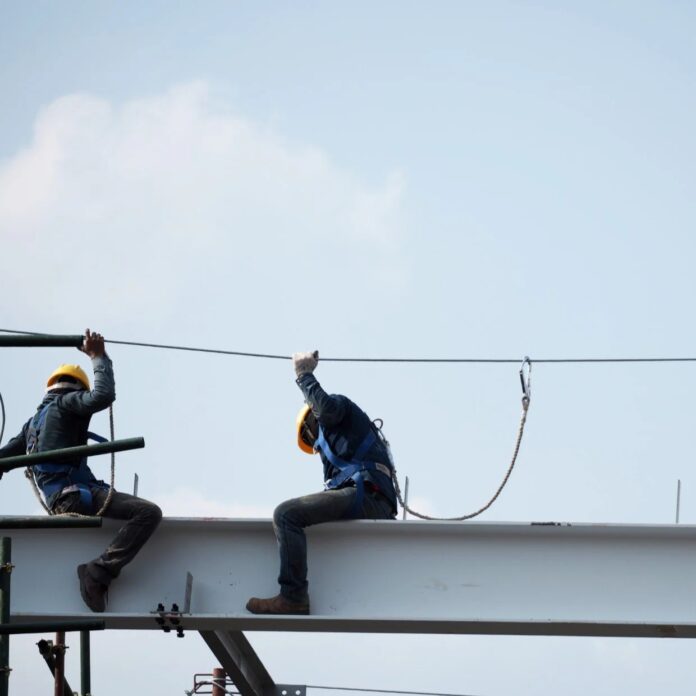Lifeline work, also known as “lifeline installation” or “fall protection lifeline systems,” refers to the installation, maintenance, and inspection of horizontal or vertical lifelines, also known as safety lines, in industrial settings.
Purpose of Lifeline Work
The primary purpose of lifeline work is to provide a safe and reliable means of fall protection for workers operating at heights, such as:
- Maintenance personnel
- Construction workers
- Inspectors
- Engineers
Types of Lifelines
There are two main types of lifelines:
- Horizontal Lifelines: These are installed horizontally between two anchor points to provide protection for workers moving along a horizontal surface.
- Vertical Lifelines: These are installed vertically to provide protection for workers climbing or descending, such as on ladders or towers.
Components of Lifeline Systems
A lifeline system typically consists of:
- Anchors: Securely attached to the structure to provide a fixed point for the lifeline.
- Lifeline: A cable, rope, or webbing that connects the anchors and provides the fall protection.
- Shocks Absorbers: Devices that absorb the energy of a fall, reducing the impact force on the worker.
- Connectors: Devices that connect the worker’s harness to the lifeline.
Importance of Lifeline Work
Lifeline work is crucial in industrial settings to:
- Prevent falls from heights
- Reduce the risk of injury or death
- Ensure compliance with regulatory requirements
- Provide a safe working environment
Regulations and Standards
Lifeline work must comply with relevant regulations and standards, such as:
- OSHA (Occupational Safety and Health Administration)
- ANSI (American National Standards Institute)
- ASME (American Society of Mechanical Engineers)
- CSA (Canadian Standards Association)
Training and Certification
Workers involved in lifeline work must receive proper training and certification to ensure they can safely install, maintain, and inspect lifeline systems.
What is the breaking strength of 20mm lifeline rope ?
The breaking strength of a 20mm lifeline rope can vary depending on the material, construction, and manufacturer of the rope.
Here are some general guidelines for the minimum breaking strength (MBS) of 20mm ropes made from different materials:
Please note that these values are approximate and can vary depending on the specific rope and manufacturer.
- Nylon Rope: 30-40 kN (6,700-8,900 lbf) (30kN = 3,059.15 kg) (40kN=4,078.86 kg)
- Polyester Rope: 35-45 kN (7,800-10,100 lbf) (35=3,569.01 kg) (45kN=4,588.72 kg)
- Polypropylene Rope: 25-35 kN (5,600-7,800 lbf) (25 kN =2,549.29 kg) (35=3,569.01 kg)
- Arborist Rope (Kernmantle): 40-50 kN (8,900-11,200 lbf)(40kN=4,078.86 kg) (50kN= 5,098.58 kg)
- Climbing Rope (Kernmantle): 50-60 kN (11,200-13,400 lbf) (50kN= 5,098.58 kg)( 60kN=6,118.3 kg)
- ( 1 kN (Kilonewtons) = 224.80894 lbf (Kilonewtons) – To convert a measurement in kilonewtons to a measurement in pound-force, multiply the force by the following conversion ratio: 224.80894 pound-force/kilonewton.
- Since one kilonewton is equal to 224.80894 pound-force, you can use this simple formula to convert:
- pound-force = kilonewtons × 224.80894 )
It’s essential to check the specifications and certifications of the rope, such as:
- EN 1891 (European Standard for Personal Fall Protection Equipment)
- ANSI Z359.1 (American National Standard for Personal Fall Protection Equipment)
- CSA Z259.2 (Canadian Standard for Personal Fall Protection Equipment)
Additionally, it’s crucial to follow proper inspection, maintenance, and usage guidelines for the lifeline rope to ensure its integrity and performance.
What Is a Kilonewton?
(1 kN is equal to 101.97 kg)
One kilonewton is equal to 1,000 newtons, which are equal to the force needed to move one kilogram of mass at a rate of one meter per second squared.
The kilonewton is a multiple of the newton, which is the SI derived unit for force. In the metric system, “kilo” is the prefix for thousands, or 103. Kilonewtons can be abbreviated as kN; for example, 1 kilonewton can be written as 1 kN.
Learn more about kilonewtons.
What Is Pound-Force?
Pound-force is a unit of force equal to the force needed to move one pound of mass at a rate of 32.174049 feet per second squared.
The pound-force is a US customary and imperial unit of force. Pound-force is sometimes also referred to as a pound of force. Pound-force can be abbreviated as lbf, and are also sometimes abbreviated as lbF. For example, 1 pound-force can be written as 1 lbf or 1 lbF.
If a man whose weight is 60 kg is falling from a height of 8 meters, then what will be his weight at the time of falling?
When the man falls, his weight remains the same, 60 kg (or 588 N, since weight = mass x gravity).
However, I think you might be asking about the force exerted on the lifeline or safety gear during the fall.
In that case, we need to consider the concept of “impact force” or “dynamic force.” As the man falls, his potential energy (due to his height) is converted into kinetic energy (due to his velocity).
Assuming a worst-case scenario where the man falls freely without any deceleration, we can estimate the impact force using the following formula:
Impact Force (F) = (mass x velocity^2) / (2 x distance)
Since we don’t know the velocity at the time of impact, we can use the equation for free fall to estimate it:
velocity (v) = √(2 x acceleration due to gravity x height)
= √(2 x 9.81 m/s^2 x 8 m)
≈ 12.5 m/s
Now, let’s calculate the impact force:
F = (60 kg x (12.5 m/s)^2) / (2 x 0.5 m) ≈ 9,375 N
So, the impact force on the lifeline or safety gear would be approximately 9,375 N, which is equivalent to about 950 kg (or 9.5 times the man’s original weight).
Please note that this calculation is simplified and doesn’t take into account various factors like air resistance, lifeline elasticity, and safety gear performance. In reality, the actual impact force might be lower due to these factors.



